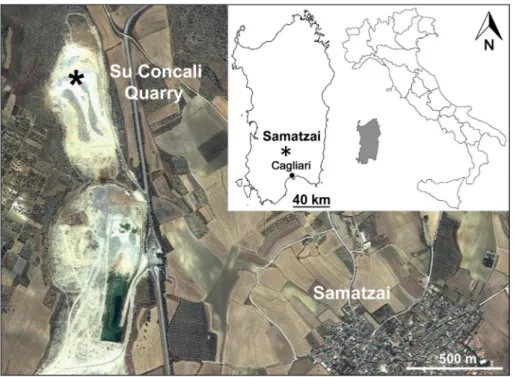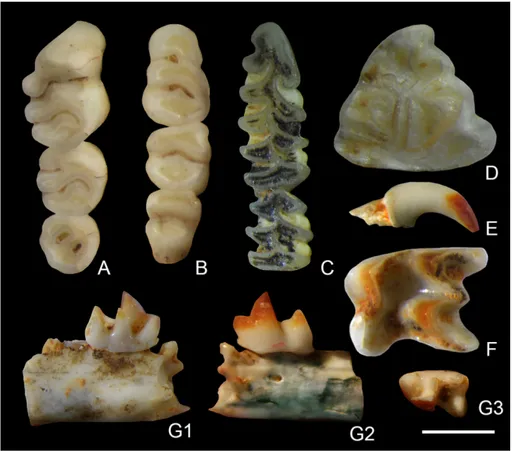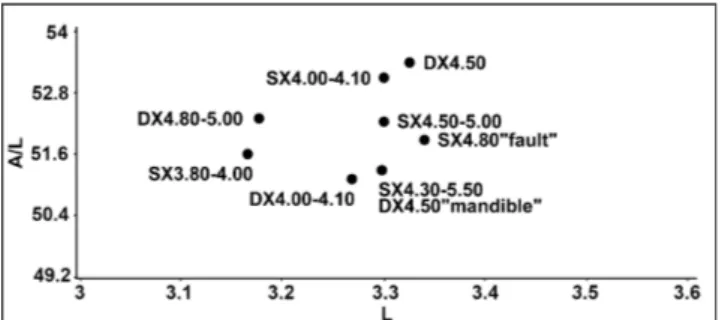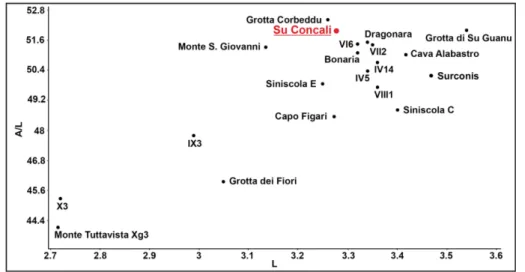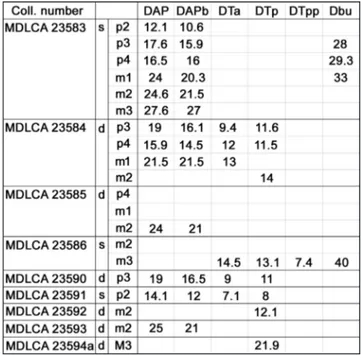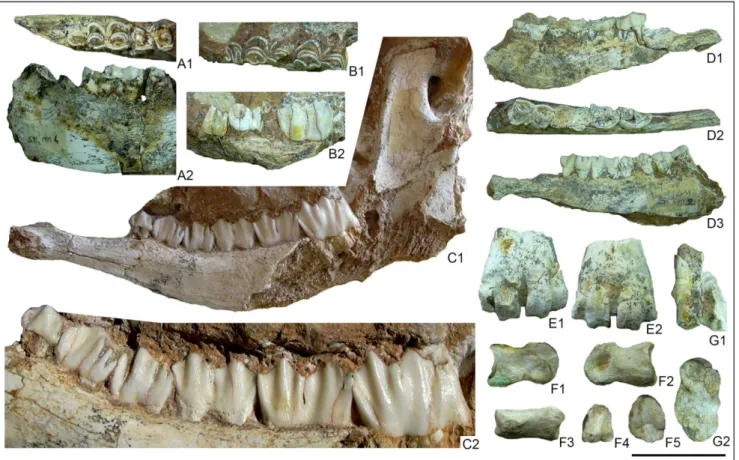UPPER PLEISTOCENE MAMMAL ASSEMBLAGE FROM SU CONCALI QUARRY (SAMATZAI, SOUTHERN SARDINIA, ITALY)
DANIEL ZOBOLI1 & GIAN LUIGI PILLOLA2
1Corresponding author. Dipartimento di Scienze Chimiche e Geologiche, Università degli Studi di Cagliari, Via Trentino 51, 09127 Cagliari.
E-mail: [email protected]
2Dipartimento di Scienze Chimiche e Geologiche, Università degli Studi di Cagliari, Via Trentino 51, 09127 Cagliari. E-mail: [email protected]
To cite this article: Zoboli D. & Pillola G.L. (2017) - Upper Pleistocene mammal assemblage from Su Concali Quarry (Samatzai, Southern Sardinia, Italy) Riv. It. Paleontol. Strat., 123(2): 243-254.
Abstract. A mammal assemblage discovered in a fissure filling located in a quarry near the village of Sa-matzai (Campidano, southern Sardinia, Italy) is described herein. The following taxa are reported: Microtus (Tyrrheni-cola) henseli, Rhagamys orthodon, Prolagus sardus, Asoriculus sp., Cynotherium sardous and Praemegaceros (Nesoleipoceros) cazioti. The assemblage (“Microtus (Tyrrhenicola)” Faunal Complex, Dragonara Faunal Subcomplex) infers a Late Pleistocene age and represents the richest deposit of Quaternary mammals reported in the central Campidano area.
Received: January 12, 2017; accepted: February 20, 2017
Keywords: Quaternary; Sardinia; Italy; Insular fauna; Vertebrate palaeontology.
I
ntroductIonPliocene-Quaternary mammalian assembla-ges of Sardinia and Corsica have been reported since the 19th century (Cuvier 1812; Studiati in Lamarmora 1857). The rich deposits of numerous Sardinian localities testify insular faunal turnovers characterized by the appearance of new elements from the mainland and the extinction of several taxa (Palombo 1985; Van der Made 1999; Sondaar 2000; Abbazzi et al. 2004; Palombo 2006; Palombo 2009).
Palombo (2009) recognized two main mam-malian faunal complexes (FC): the oldest “Nesogo-ral” FC (Late Pliocene - Early Pleistocene), divided
into two subcomplexes (FSC) (Mandriola FSC and Capo Figari/Orosei 1 FSC) and the more recent “Microtus (Tyrrhenicola)” FC (late Early Pleistocene
- early Holocene), divided into two FSC: Orosei 2 FSC and Dragonara FSC.
The Pliocene-Quaternary mammal remains of Sardinia primarily originate from karstic fissure fillings and subordinately from aeolian and fluvial-lacustrine deposits. However, the most of the fossi-liferous localities are located in correspondence of mainly calcareous outcrops, mostly outside the cen-tral areas of Sardinia (Studiati in Lamarmora 1857; Dehaut 1911; Comaschi Caria 1968; Malatesta 1970;
Abbazzi et al. 2004). Therefore, the description of new fossiliferous sites from poorly investigated are-as of Sardinia represents an additional source of data.
In the 2004, during the quarrying activity of the Company “Italcementi S.p.A.”, several deer bone fragments were discovered within a fissure fil-ling located in the Su Concali Quarry, near the villa-ge of Samatzai (Cagliari, Sardinia). In the same year an excavation campaign was conducted by a team of the University of Cagliari in order to recover the palaeontological material. The aim of this paper is to provide a preliminary description of the new mammal assemblage of Su Concali Quarry and to propose a biochronological assignment.
G
eoloGIcalsettInGThe studied fissure filling was located in the limestone quarry named Su Concali, about 2 km NW from the village of Samatzai (Campidano, southern Sardinia, Fig. 1). Currently, the fossilifer-ous site is no longer present due to the ongoing quarrying activity.
The quarry was opened in the marine succes-sion of the Villagreca Limestone (upper Oligocene - lower Burdigalian) (Pecorini & Pomesano Cherchi 1969) and the Quaternary fossiliferous deposit was represented by multiple phases of filling due to wa-ter flows (Fig. 2).
Three layers characterized by different types of sediments were distinguishable in the fissure fill-ing. From top to bottom they are:
- Soil (Fig. 2B-c).
- Uncemented red clay (Fig. 2B-d), localized between the soil and the underlying cemented red
claystone. Poorly preserved vertebrate remains were found in this layer (1.9 m).
- Poorly cemented red clay (Fig. 2B-e) with a heterogeneous structure and a huge number of bone fragments (2 m).
- Highly cemented bed with siliciclastic sedi-ments, heterometric calcareous pebbles and indica-tions of probable landslides (Fig. 2B-f). This bed was characterized by the presence of stalactites and other carbonate concretions that covered the walls of the cavity, the pebbles and several deer bones (1.4 m).
The deer bones are generally highly fragment-ed and poorly preservfragment-ed. Indefragment-ed, it was possible to identify only a limited number of elements, mainly related to teeth, jaws and limb bones. The state of preservation of the bones probably indicates a long transportation by water flows.
Fig. 1 - Location map of the Su Con-cali Quarry.
Fig. 2 - A) Overview of the Su Concali Quarry during the palaeon-tological excavation campaign (July, 2004); the white arrow indicates the position of the fossiliferous site. B) The fissure filling before the excavation and location of the sampling points: a, marly limestones (upper Oligocene - lower Bur-digalian); b, ostreid-bearing limestones (upper Oligocene - lower Burdigalian); c, soil; d, uncemented red clay; e, poorly cemented red clay; f, highly cemented level with carbonate concretions; g, debris; 1, SX3.80-4.00m; 2, SX4.00-4.10m; 3, SX4.30-4.50m; 4, SX4.80m“fault”; 5, SX4.50-5.00m; 6, DX4.00-4.10m; 7, DX4.50m“mandible”; 8, DX4.50m; 9, DX4.80-5.00m.
MaterIalsandMethods
We used an air engraving pen (3400BPM) to prepare the macromammal bones. Afterwards, the most fragile fossils were con-solidated using Paraloid B-72. Subsequently, we used a digital caliper (Rupac 0-150mm/0.01 ABS) to measure the macromammal remains. We collected sediments from different levels of the fissure filling (Fig. 2B) in order to recover the small fossil remains: SX3.80-4.00m, SX4.00-4.10m and DX4.00-4-10m from the poorly cemented red clay, and SX4.30-4.50m, SX4.80m“fault”, SX4.50-5.00m, DX4.50m “mandible”, DX4.50m and DX4.80-5.00m from the highly cement-ed level. The samplcement-ed scement-ediments were siftcement-ed using wet sieves (2.5 - 0.5 mm) and afterward the dried residues were inspected using a Leica MS5 stereomicroscope to recover micromammal remains. Measurements and photographs of the studied micromammal fos-sils were performed using a Nikon D5000 mounted on a Leica MS5 stereomicroscope. Comparison was made using samples stored in the Museo Sardo di Geologia e Paleontologia D. Lovisato of Cagliari and literature data (Malatesta 1970; Caloi & Malatesta 1974; Mezza-botta et al. 1995; Minieri et al. 1995; Abbazzi et al. 2005; Van der Made & Palombo 2006; Madurell-Malapeira et al. 2015).
Forty-four m1 of Microtus (Tyrrhenicola) henseli (Major, 1905) have been studied. Comparison was made with samples of M. (Tyr-rhenicola) spp. from various Sardinian localities (data from Mezzabot-ta et al. 1995; Minieri et al. 1995; Marcolini et al. 2005, 2006; Boldrini 2008; Boldrini et al. 2010; Zoboli & Pillola 2016). Measurements and morphological indices of m1 of M. (Tyrrhenicola) henseli were taken according to Van der Meulen (1973) and Marcolini et al. (2006) with further modifications as proposed by Boldrini (2008). The nomen-clature and the measurements used in this paper follow Michaux (1971) for the murid teeth, López Martínez (1989) and Angelone (2007) for the ochotonid teeth and Reumer (1984) for the soricid teeth. Macromammal remains were measured according to Von den Driesch (1976) and Van der Made (2012). All measurements are given in mm. The studied material is stored at the Museo Sardo di Geologia e Paleontologia Domenico Lovisato of the University of Cagliari.
Abbreviations
Institutions: MDLCA, Museo Sardo di Geologia e Paleon-tologia Domenico Lovisato, University of Cagliari. Terminology, measurements and morphological indices of the occlusal surface of the first lower molar of Microtus (Tyrrhenicola) henseli: ACC, antero-conid complex; TTC, trigonid-talonid complex; AC, anterior cap; T, triangle; BSA, buccal salient angle; BRA, buccal reentrant angle; LSA, lingual salient angle; LRA, lingual reentrant angle; PL, terior loop; V1, total length; V2, total width; V3, Length of pos-terior part of BRA2; V4, width of the neck; A/L, length of ACC against total length (V1-V3)/V1 *100; LAC, V4/V1; W/L, width against total length; min, minimum; max, maximum; n, number of measured elements. Measurements of firsts cheek teeth of Rhaga-mys orthodon: L, total length; W, total width; n, number of mea-sured elements. Measurements of Soricidae teeth: PE, length of the posterior emargination; LL, lingual length; BL, buccal length; AW, anterior width; PW, posterior width; TRW, trigonid width, TAW, talonid width; L, length. Measurements of the p3 of Prolagus sardus: L max, maximum length; L min, minimum length; L mean, mean length; W max, maximum width; W min, minimum width; W mean, mean width. Measurements of teeth and mandibles of Praemegaceros (Nesoleipoceros) cazioti: DAP: antero-posterior diameter (or tooth length), DAPb: DAP measured at the base of a tooth, DTa: transverse diameter of the anterior lobe, DTp: transverse diameter of the posterior lobe, DTpp: transverse diameter of the
third lobe in a m3, Dbu, depth of the mandible measured below each cheek tooth from p2 to m3, depth is measured at the lingual side; d, right elements; s, left elements.
s
ysteMatIcpalaeontoloGyOrder Rodentia Bowdich, 1821
Family Cricetidae Fischer, 1817 Genus Microtus Schrank, 1798
Subgenus Tyrrhenicola Major, 1905
Microtus (Tyrrhenicola) henseli (Major, 1905) Fig. 3C
Material: MDLCA23622: one isolated m1, two incomplete
hemimandibles and one incomplete maxillae from SX3.80-4.00m; MDLCA23623: two m1 and one incomplete hemimandible from SX4.00-4.10m; MDLCA23624: nine m1 from DX4.00-4-10m; MDLCA23625: one isolated m1 and one incomplete hemimandi-ble from SX4.30-4.50m; MDLCA23626: two m1 from SX4.80m “fault”; MDLCA23627: eleven isolated m1 and two right incomple-te hemimandibles from SX4.50-5.00m; MDLCA23628: one isolaincomple-ted m1 and one incomplete hemimandible from DX4.50m“mandible”; MDLCA23629: two isolated m1 and three incomplete hemimandi-bles from DX4.50m; MDLCA23630: five m1 and one incomplete hemimandible from DX4.80-5.00m.
Remarks. Microtus (Tyrrhenicola) is the most
abundant micromammal of the fissure filling. The analyzed m1 are characterized by long and asym-metrical anterior cap, developed sixth triangle and narrow neck (Fig. 3C).
The first lower molar of M. (Thyrrhenicola)
spp. shows a wide morphologic variability. Mez-zabotta et al. (1995) recognize four morphotypes classes of m1. The most primitive class includes small m1 with a simple and short anterior cap, large neck and poorly developed or absent T6, whereas the most derived class includes large m1 with long asymmetrical anterior cap, developed T6, narrow neck and always present T7. The intermediate clas-ses include m1 with transitional features (Mezza-botta et al. 1995).
The analysis of m1 of M. (Tyrrhenicola) from
Su Concali (Figs 4-5, Tabs 1-2) attest the presen-ce of advanpresen-ced morphotypes in all levels of the fissure filling. The sample appears to be compara-ble with the most advanced M. (Thyrrhenicola) hense-li populations of Sardinia and differs widely from
the primitive morphotypes of M. (Tyrrhenicola) hen-seli and M. (Tyrrhenicola) sondaari Marcolini, Tuveri,
Fig. 3 - Micromammals of Su Con-cali Quarry. A, B) Rhaga-mys orthodon from SX4.30-4.50m (MDLCA23621), A - M1-M3 in occlusal view, B - m1-m3 in occlusal view. C) Microtus (Tyrrhenicola) henseli from SX4.50-5.00m (MDLCA23627), m1-m2 in occlusal view. D) Prolagus sardus from SX4.00-4.10m (MDLCA23631), p3 in oc-clusal view. E, F, G) Asoricu-lus sp. from SX4.80m“fault” (MDLCA23634), E - upper right incisor in labial view, F - left M2 in occlusal view, G - incomplete left mandible with incomplete p4 and m1 in lingual 1) and buccal 2) views, and m1 in occlusal view 3). Scale bar: figs A-D = 1 mm; figs E, G = 2 mm; fig. F = 1.5 mm.
Tab. 1 - Measurements (in mm), de-scriptive statistics of varia-bles and morphological indi-ces of the first lower molar of Microtus (Tyrrhenicola) hen-seli from various levels of Su Concali Quarry.
Family Muridae Illiger, 1811 Genus Rhagamys Major, 1905
Rhagamys orthodon (Hensel, 1856) Fig. 3A, B
Material: MDLCA23618: four isolated M1, five isolated M2,
two isolated M3, three isolated m1 and one isolated m2 from DX4.80-5.00m; MDLCA23619: three isolated M1, two isolated M2, two iso-lated m1 and one incomplete left hemimandible with incisive and m1 from DX4.50m; MDLCA23620: one isolated M2, five isolated m1, one isolated m2, two isolated m3, one fragmentary left hemimandi-ble with incisive and m1, one incomplete hemimandihemimandi-ble with m2-m3
and one fragmentary right hemimandible with m1-m2 from SX4.80 “fault”; MDLCA23621: four isolated M1, two isolated M2, one isola-ted m1, two isolaisola-ted m2, one isolaisola-ted m3, two incomplete right hemi-mandibles and one incomplete left maxilla from SX4.30-4.50.
Remarks. The cheek teeth of the murid of
Su Concali Quarry are characterized by marked hypsodonty, the unworn M1 show the first and the second tubercles not clearly separated.
An endemic murid lineage is known in the Plio-Quaternary of the Corso-Sardinian massif.
Rhagapodemus azzarolii Angelone & Kotsakis, 2001,
the oldest taxon of this lineage, is reported in the Capo Mannu D1 local fauna (Madriola) (Angelone & Kotsakis 2001; Abbazzi et al. 2008; Piras et al. 2012). Rhagapodemus minor (Brandy, 1978) is the
sec-ond taxon of the lineage and is reported in a few Early Pleistocene localities of Sardinia and Corsi-ca (Brandy 1978; Abbazzi et al. 2004; Piras et al. 2012). Rhagamys orthodon (Hensel, 1856) represents
the most recent and common species, reported in several localities from the Middle Pleistocene to the Early Holocene (Comaschi Caria 1968; Vi-gne 1992). The transition between R. minor and R. orthodon is marked by an increase in dimension and
hypsodonty (Brandy 1978; Piras et al. 2012). Based on their size, the samples from Su Concali Quarry are clearly referable to R. orthodon (Fig. 7, Tab. 3).
Order Lagomorpha Brandt, 1855
Family Ochotonidae Thomas, 1897 Genus Prolagus Pomel, 1853
Prolagus sardus (Wagner, 1829) Fig. 3D
Fig. 4 - A) Terminology of the first lower molar occlusal surface of cricetids (modified from Van der Meulen 1973). B) Sketch of measurements of the m1 of Microtus (Thyrrhenicola) henseli.
Fig. 5 - L against A/L of m1 of Microtus (Tyrrhenicola) henseli from various levels of Su Concali Quarry.
Tab. 2 - Measurements (in mm), descriptive statistics of variables and morphological indices of the m1 of Microtus (Tyrrhenico-la) henseli of Su Concali Quarry.
Tab. 3 - Measurements (in mm) of the first cheek teeth of Rhagamys orthodon of Su Concali Quarry.
Material: MDLCA23631: three incomplete hemimandibles,
two incomplete lower incisors and five incomplete cheek teeth from SX4.00-4.10m; MDLCA23632: one incomplete hemimandible, five cheek teeth fragments and one incomplete right femur from SX4.30-4.50; MDLCA23633: two incomplete hemimandibles, one incomple-te maxilla, two incompleincomple-te cheek incomple-teeth and one incompleincomple-te upper incisor from DX4.00-4.10m.
Remarks. Prolagus is represented by isolated
teeth, incomplete hemimandibles and poorly pre-served postcranial elements. Only three isolated p3 (MDLCA23631) with a complete occlusal surface
have been measured (L max = 2.27, L min = 2.21, L mean = 2.23, W max = 2.51, W min = 2.39, W mean = 2.45). The collected teeth show a posteri-orly indented and lingually elongated anteroconid (Fig. 3D).
Prolagus sardus is probably the most common
taxon in the Quaternary insular mammal assem-blages of Sardinia and Corsica. This lagomorph is typical of the Dragonara FCS and its fossils are usually very abundant in caves, fissure fillings and anthropogenic deposits of the end of the Middle Pleistocene - Early Holocene (until the Iron Age) (Comaschi Caria 1968; Vigne 1992; Wilkens 2000).
Unexpectedly, Prolagus remains are scarce and
poorly preserved in the fissure filling. However, the features of the ochotonid of Su Concali suggest a
comparison with the advanced morphotypes recog-nized by Angelone et al. (2008).
Order Eulipotyphla Waddell, Okada
& Hasegawa, 1999 Family Soricidae Fischer, 1814 Genus Asoriculus Kretzoi, 1959
Asoriculus sp. Fig. 3E, F, G
Material: MDLCA23634: two upper right incisors, one
left M2, one incomplete left hemimandible with incomplete p4 and complete m1 and one isolated incomplete m1 from SX4.80m“fault;” MDLCA23635: nine fragments of cheek teeth from SX4.80m“fault”.
Remarks. The upper incisors are bifid with stout
and not very elongated first cousp. The M2 shows
a well developed metacone crest. In the posterior Fig. 6 - L against A/L of m1 of
Mi-crotus (Tyrrhenicola) spp. from various localities of Sardinia. Monte Tuttavista Xg3 is the type locality of M. (Tyrrheni-cola) sondaari (data from Mez-zabotta et al. 1995; Minieri et al. 1995; Marcolini et al. 2005, 2006; Boldrini 2008 and Zoboli & Pillola 2016).
Fig. 7 - L against W of the first cheek teeth of Rhagapodemus azzaro-lii, Rhagapodemus minor and Rhagamys orthodon from various localities of Sardinia and Corsica (data from Brandy 1978; Gliozzi et al. 1984; Angelone & Kotsakis 2001 and Zoboli & Pillola 2016).
wall of the tooth, a wide groove is present between the metacone and hypocone. The m1 shows a straight lingual wall, aligned paraconid and meta-conid, developed hypoconid and entoconid and a lingually developed cingulum. The following linear measurements have been taken from two teeth: M2: AW = 3.62, PW = 3.22, BL = 2.65, PE = 2.31, LL = 2.74; m1: L = 2.14, TRW = 1.17, TAW = 1.33.
Two formally described species and two un-determined species attributed to the genus Asori-culus are reported in Sardinia (Van der Made 1999;
Abbazzi et al. 2004; Furió & Angelone 2010). The oldest remains of this genus are reported in the Late Pliocene of Capo Mannu D1 (often cited as Mandriola, central-western Sardinia) and were at-tributed to the European mainland form Asoricu-lus gibberodon (Peteneyi, 1864) (Furió & Angelone
2010). Several endemic forms probably evolved from A. gibberodon are recognized in the
Quaterna-ry of the Corso-Sardinian massif: Asoriculus corsi-canus (Bate, 1945), Asoriculus similis (Hensel, 1855), “Nesiotites” (=Asoriculus) sp. 1 (bigger and recent
form from Mt. Tuttavista) and “Nesiotites” (=Aso-riculus) sp. 2 (smaller and oldest form from Mt.
Tuttavista). Asoriculus similis is the most common
shrew in the Sardinian fossil record. This taxon, initially classified as Sorex similis by Hensel (1855),
is a relatively big size shrew signaled in the Late
Pleistocene - Early Holocene. Bate (1945) included all the Corso-Sardinian and the Balearic shrews in the new genus Nesiotites; however, in recent times
only the Balearic forms are generally attributed to this genus (Van der Made 1999; Rofes et al. 2012) while the Corso-Sardinian fossils are usually refer-red to “Nesiotites” (Abbazzi et al. 2004; Furió &
Angelone 2010) or Asoriculus (Van der Made 1999;
Rofes et al. 2012).
Pending a revision of the Corso-Sardinian shrews, the Soricidae of Su Concali Quarry is re-ferred to Asoriculus sp.
Order Carnivora Bowdich, 1821
Family Canidae Fischer, 1817 Genus Cynotherium Studiati, 1857
Cynotherium sardous Studiati, 1857 Fig. 8
Material: MDLCA23614: one incomplete left M1;
MDL-CA23615: one right m2; MDLCA23616: one incomplete right m2; MDLCA23617: one incomplete left I3. All material from DX4.00m.
Remarks. Four isolated and incomplete
teeth are the only Canidae remains found in the deposit. A right m2 (MDLCA23615, Fig. 8A) is the only tooth that presents a complete crown. This bean-shaped and bicuspidate tooth is somewhat Fig. 8 - Cynotherium sardous from Su
Concali Quarry. A) MDL-CA23615, isolated right m2 in occlusal 1), buccal 2) and lingual 3) views. B) MDLCA23614, incomplete left M1 in occlusal 1) and anterior 2) views. C) MDL-CA23617, incomplete left I3 in lingual 1) and buccal 2) views. Scale bar = 1 cm.
Order Artiodactyla Owen, 1848
Family Cervidae Goldfuss, 1820 Genus Praemegaceros Portis, 1920
Subgenus Nesoleipoceros Radulesco & Samson, 1967
Praemegaceros (Nesoleipoceros) cazioti
(Depéret, 1897) Fig. 10
Material: MDLCA23583: incomplete left hemimandible
with p2-m3; MDLCA23584: incomplete right hemimandible with p3-m2; MDLCA23585: incomplete right hemimandible with p4-m2; MDLCA23586: incomplete left hemimandible with m2-m3; MDLCA23587: incomplete right hemimandible with p2-p3 ro-ots; MDLCA23588: one incomplete right i1; MDLCA23589: one incomplete left i2; MDLCA23590: one isolated right p3; MDL-CA23591: one isolated left p2; MDLCA23592: one incomplete right m2; MDLCA23593: one incomplete right m2; MDLCA23594a-b: two incomplete right M3; MDLCA23595: one right M2 fragment; MDLCA23596, MDLCA23597, MDLCA23598, MDLCA23600: four incomplete right humeri; MDLCA23599, MDLCA23601: two incomplete left humeri; MDLCA23602, MDLCA23603: two incom-plete left radii; MDLCA23604: one incomincom-plete right tibia; CA23605, MDLCA23606: two metapodial distal fragments; MDL-CA23607: one incomplete left astragalus; MDLCA23608: one left unciform; MDLCA23609: one left capitate; MDLCA23610, MDL-CA23611: two second phalanges; MDLCA23612, MDLCA23613: two third phalanges.
Remarks. Most part of the megacerine deer
remains was found in the lower and highly cement-ed level of the fissure filling. The fossils are rela-worn but still shows the peculiar features of the
genus Cynotherium (Studiati in Lamarmora 1857;
Malatesta 1970). This m2 is 8.92 in length and 5.80 in width. The other collected teeth show in-complete crowns and broken roots. The crown of the only recovered M1 is incompletely preserved (MDLCA23614, Fig. 8B). A one-rooted tooth with broken crown is probably referable to an upper in-cisive (MDLCA23617, Fig. 8C).
Cynotherium represents one of the most
pe-culiar elements in the mammalian assemblages of Sardinia and Corsica during the Quaternary. This insular genus was established by Studiati (1857) based on the material collected by Lamarmora in the Pleistocene breccias of Bonaria (Cagliari).
Cynotherium is present in the Corso-Sardinian
massif with two species: C. sardous Studiati, 1857
(Middle - Late Pleistocene) and its ancestor C. ma-latestai Madurell-Malapeira et al., 2015 (?late Early
Pleistocene and/or early Middle Pleistocene). Fur-thermore, Abbazzi et al. (2005) reported Canidae indet., Cynotherium sp. and Cynotherium cf. sardous
from several fissure fillings of Mt. Tuttavista. In agreement with the detailed description of this taxon provided by Malatesta (1970), the ca-nid from Su Concali Quarry shows several of the main features that characterize the endemic genus
Cynotherium. The dentition is comparable in size
with the most recent C. sardous and differs from
the oldest samples of Mt. Tuttavista and C. ma-latestai (Fig. 9). Therefore, the canid remains from
Samatzai are assigned to C. sardous.
Fig. 9 - m2 proportions in Cynotherium sardous from Su Concali Quarry compared with C. sardous, C. cf. sardous, C. sp. and C. malatestai from various localities of Sardinia. VII-2, VI-B6 and XI-Dic are fissure fillings of Mt. Tuttavista. Measure-ments were taken from the literature (Malatesta 1970 for Dragonara Cave, Abbazzi et al. 2005 for Mt. Tuttavista and Madurell-Malapeira et al. 2015 for C. malatestai).
Tab. 4 - Measurements (in mm) of the teeth and hemimandibles of Praemegaceros (Nesoleipoceros) cazioti of Su Concali Quarry.
tively abundant; however, the samples are generally poorly preserved and are represented by isolated teeth, fragments of hemimandibles and incomplete limb bones (Fig. 10). Furthermore, a conspicuous number of indeterminable small bone fragments was found in all levels of the fissure filling. Nev-ertheless, it was possible to take some linear mea-surements from the most complete bones and teeth (Tab. 4). The greater part of the samples probably belongs to female specimens, in fact, antlers or rela-tively large bones referable to male specimens were not found. The collected bones belong to adult and old individuals as shown by the teeth wear in the sample MDLCA23584 (Fig. 10D).
Megacerine are relatively common in the Qua-ternary fossil record of the Corso-Sardinian massif. Two species are reported in Sardinia: Praemegaceros
(Nesoleipoceros) cazioti (Depéret, 1897) and Praemegace-ros (NesoleipocePraemegace-ros) sardus (Van der Made & Palombo,
2006). P. (N.) sardus is considered the bigger sized
(about 25-40%) ancestor of the most common and
recent P. (N.) cazioti. Praemegaceros solilhacus (Robert,
1830) is considered the mainland ancestor of this insular lineage (Vislobokova 2013).
The deer remains of Su Concali Quarry are comparable in size with the Late Pleistocene sam-ples of Medusa/Dragonara Cave (Caloi & Malates-ta 1974) and are assigned to the most recent mega-cerine species P. (N.) cazioti.
d
IscussIonandconclusIonsThe Su Concali Quarry mammal assemblage includes the following taxa: Microtus (Tyrrhenicola) henseli, Rhagamys orthodon, Prolagus sardus, Asoriculus
sp., Cynotherium sardous and Praemegaceros (Nesoleipoc-eros) cazioti. These mammals are well known in
sev-eral Quaternary localities of the Corso-Sardinian massif.
The presence of Cervidae, Canidae and Ar-vicolinae excludes the “Nesogoral” Faunal Complex
Fig. 10 - Praemegaceros (Nesoleipoceros) cazioti from Su Concali Quarry. A) MDLCA23586, incomplete left hemimandible with m2-m3 in oc-clusal 1) and lingual 2) views. B) MDCA23585, incomplete right hemimandible with p4-m2 in ococ-clusal 1) and lingual 2) views. C) MDLCA23583, left hemimandible with p2-m3 in lingual 1) view and detail of the teeth 2). D) MDLCA23584, incomplete right hemi-mandible with p3-m2 in buccal 1), occlusal 2) and lingual 3) views. E) MDLCA23605, distal fragment of metapodial in posterior 1) and anterior 2) views. F) MDLCA23611, second phalanx in abaxial 1), axial 2), dorsal 3), distal 4) and proximal 5) views. G) MDLCA23607, incomplete left astragalus in anterior 1) and lateral 2) views. Scale bar = 5 cm, except for C2 = 2.5 cm.
in favor of the most recent “Microtus (Thyrrhenicola)”
Faunal Complex.
The morpho-dimensional analysis of the col-lected taxa seem to indicate the typical mammal as-semblage of the Late Pleistocene (Dragonara Faunal Subcomplex) and furthermore, the absence of taxa introduced by man tend to exclude an early Holocene age. In conclusion, the fissure filling of Su Concali Quarry represents the richest Quaternary mammals deposit reported in the central Campidano.
Acknowledgements. We gratefully acknowledge Sardinia
Regio-nal Government for the financial support of the PhD scholarship (P.O.R. Sardegna F.S.E. Operational Programme of the Autonomous Region of Sardinia, European Social Fund 2007-2013 - Axis IV Hu-man Resources, Objective l.3, Line of Activity l.3.1.). We are grateful to the referees A. Kotsakis, L. van den Hoek, F. Masini and the asso-ciate editor L. Rook for their suggestions.
RefeRences
Abbazzi L., Angelone C., Arca M., Barione G., Bedetti C., Del-fino M., Kotsakis T., Marcolini F., Palombo M.R., Pavia M., Piras P., Rook L., Torre D., Tuveri C., Valli A.M.F. & Wilkens B. (2004) - Plio-Pleistocene Fossil Vertebrates of Monte Tuttavista (Orosei, E. Sardinia, Italy), An overview. Riv. It. Paleontol. Strat., 110: 603-628.
Abbazzi L., Arca M., Tuveri C. & Rook L. (2005) - The en-demic canid Cynotherium (Mammalia, Carnivora) from
the Pleistocene deposits of M. Tuttavista (Nuoro, East-ern Sardinia). Riv. It. Paleontol. Strat., 111: 497-511.
Abbazzi L., Carboni S., Delfino M., Gallai G., Lecca L. & Rook L. (2008) - Fossil vertebrates (Mammalia and Reptilia) from Capo Mannu Formation (Late Pliocene, Sardinia, Italy), with description of a new Testudo (Chelonii,
Tes-tudinidae) species. Riv. It. Paleontol. Strat., 114: 119-132.
Angelone C. (2007) - Prolagus (Ochotonidae, Lagomorpha,
Mammalia) of Italy. Géobios, 40: 407-421.
Angelone C. & Kotsakis T. (2001) - Rhagapodemus azzarolii n.
sp. (Muridae, Rodentia) from the Pliocene of Mandriola (Western Sardinia - Italy). Boll. Soc. Paleontol. It., 40:
127-132.
Angelone C., Tuveri C., Arca C., López Martínez N. & Kot-sakis T. (2008) - Evolution of Prolagus sardus
(Ochotoni-dae, Lagomorpha) in the Quaternary of Sardinia Island (Italy). Quat. Int., 182: 109-115.
Bate D.M.A. (1945) - Pleistocene shrews from the larger West-ern Mediterranean Islands. Ann. Mag. Nat. Hist., ser. 11,
11: 738-769.
Boldrini R. (2008) - Microtus (Tyrrhenicola) henseli (Major, 1905)
di Grotta dei Fiori (Sardegna sudoccidentale): caratteri evolutivi e interpretazione biocronologica. Geol. Romana,
41: 55-64.
Boldrini R., Palombo M.R., Iacumin P. & Melis R.T. (2010) - The Middle Pleistocene fossiliferous sequence of Grot-ta dei Fiori (Sardinia, IGrot-taly): multidisciplinary analysis.
Boll. Soc. Paleontol. It., 49: 123-134.
Brandy L.D. (1978) - Données nouvelles sur l’évolution du rongeur endémique fossile corso-sarde Rhagamys F.
Ma-jor (1905) (Mammalia, Rodentia). Bull. Soc. Geol. Fr., sér. 7, 20: 831-835.
Cuvier G. (1812) - Recherches sur les ossemens fossiles de quadrupèdes, où l’on rétablit les caractères de plusieurs espèces d’animaux que les révolutions du globe parois-sent avoir détruites. Des brèches osseuses de Corse, Ar-ticle IV: 20-25.
Caloi L. & Malatesta A. (1974) - Il cervo pleistocenico di Sar-degna. Mem. Ist. It. Paleontol. Um., 3: 1-246.
Comaschi Caria I. (1968) - Fossili marini e continentali del Quaternario della Sardegna - In: Maxia C. (Eds) - Atti del X Congresso Internazionale di Studi Sardi (Simposio sul Quaternario Sardo): 139-230.
Dehaut E.G. (1911) - Animaux fossiles du Cap Figari. Ma-tériaux pour servir à l’histoire zoologique et paléon-tologique des îles de Corse et de Sardaigne, 3: 53-59. Furió M. & Angelone C. (2010) - Insectivores (Erinaceidae,
Soricidae, Talpidae; Mammalia) from the Pliocene of Capo Mannu D1 (Mandriola, central-western Sardinia, Italy). N. Jb. Geol. Paläont. Abh., 258: 229-242.
Hensel R.F. (1855) - Beiträge zur Kenntniss fossiler Säugeth-iere Insectenfresser und NagethSäugeth-iere der Diluvialforma-tion. Z. Deutsch. Geol. Gesellsch., 7: 458-501.
López Martínez N. (1989) - Revisión sistemática y bioes-tratigráfica de los Lagomorpha (Mammalia) del Ter-ciario y Cuaternario de España. Mem. Mus. Paleontol. Univ. Zaragoza, 3: 1-342.
Madurell-Malapeira J., Palombo M.R. & Sotnikova M. (2015) -
Cynotherium malatestai, sp. nov. (Carnivora, Canidae) from
the early middle Pleistocene deposits of Grotta dei Fiori (Sardinia, Western Mediterranean). J. Vert. Paleontol., 35,
Doi:10.1080/02724634.2014.943400.
Malatesta A. (1970) - Cynotherium sardous Studiati, an extinct
canid from the Pleistocene of Sardinia. Mem. Ist. It. Pale-ontol. Um., 1: 1-72.
Marcolini F., Arca M., Kotsakis T. & Tuveri C. (2005) - The endemic vole Tyrrhenicola (Arvicolidae, Rodentia) from
Monte Tuttavista (Sardinia, Italy): new perspectives for phylogeny and biochronology. Boll. Soc. Hist. Nat. Bal.,
12: 185-192.
Marcolini F., Tuveri C., Arca M. & Kotsakis T. (2006) - Microtus
(Tyrrhenicola) sondaari n. sp. (Arvicolidae, Rodentia) from
Monte Tuttavista (Sardinia, Italy). J. Geosci., 41: 73-82.
Mezzabotta C., Masini F. & Torre D. (1995) - Microtus (Tyr-rhenicola) henseli, endemic fossil vole from Pleistocene
and Holocene localities of Sardinia and Corsica: evolu-tionary patterns and biochronological meaning. Boll. Soc. Paleontol. It., 34: 81-104.
Michaux J. (1971) - Muridae (Rodentia) néogènes d’Europe sud-occidentale. Evolution et rapports avec les formes actuelles. Paléob. Cont., 2: 1-67.
Minieri M.R., Palombo M.R. & Scarano M. (1995) - Microtus
(Tyrrhenicola) henseli (Major, 1882) del Pleistocene
supe-rior di Cava Alabastro (Is Oreris; Iglesias; Sardegna su-doccidentale). Geol. Romana, 31: 51-60.
Palombo M.R. (1985) - I grandi mammiferi pleistocenici delle isole del Mediterraneo: tempi e vie di migrazione. Boll. Soc. Paleontol. It., 24: 201-224.
Palombo M.R. (2006) - Biochronology of the Plio-Pleistocene terrestrial mammals of Sardinia: the state of the art. Hel-lenic J. Geosc., 41: 47-66.
Palombo M.R. (2009) - Biochronology, paleobiogeography and faunal turnover in western Mediterranean Cenozoic mammals. Integr. Zool., 4: 367-386.
Pecorini G. & Pomesano Cherchi A. (1969) - Ricerche geo-logiche e biostratigrafiche sul Campidano meridionale (Sardegna). Mem. Soc. Geol. It., 8: 421-451.
Piras P., Sansalone G., Marcolini F., Tuveri C., Arca M. & Kotsakis T. (2012) - Evolutionary trends and stasis in molar morphology of Rhagapodemus-Rhagamys lineage in
the Pleistocene of Sardinia. Riv. It. Paleontol. Strat., 118:
535-543.
Reumer J.W.F. (1984) - Ruscinian and early Pleistocene Sori-cidae (Insectivora, Mammalia) from Tegelen (The Neth-erlands) and Hungary. Scr. Geol., 73: 1-173.
Rofes J., Bover P., Cuenca-Bescós G. & Alcover J. A. (2012) -
Nesiotites rafelinensis sp. nov., the earliest shrew
(Mamma-lia, Soricidae) from the Balearic Islands, Spain. Palaeont. Electr., 15: 1-12.
Sondaar P.Y. (2000) - Early Human Exploitation and Explora-tion of Islands. Tropics, 10: 203-230.
Studiati C. (1857) - Descriptions des fossiles de la brèche os-seuse de Monreale de Bonaria près de Cagliari. In: La Marmora A. de, Voyage en Sardaigne, III partie, 2: 651-704.
Van der Made J. (1999) - Biogeography and stratigraphy of the Mio-Pleistocene mammals of Sardinia and the de-scription of some fossils. In: Reumer J.W.F. & de Vos J.
(Eds) - Elephants have a snorkel! Papers in honour of P.Y. Sondaar. Deinsea, 7: 337-360.
Van der Made J. (2012) - The latest Early Pleistocene giant deer Megaloceros novocarthaginiensis n. sp. and the fallow
deer Dama cf. vallonnetensis from Cueva Victoria (Murcia,
Spain). Mastia, 11/13: 269-323.
Van der Made J. & Palombo M.R. (2006) - Megaloceros sardus n.
sp., a large deer from the Pleistocene of Sardinia. Hellenic J., 41: 163-176.
Van der Meulen A.J. (1973) - Middle Pleistocene smaller mam-mals from the Monte Peglia (Orvieto, Italy) with special reference to the phylogeny of Microtus (Arvicolidae,
Ro-dentia). Quaternaria, 17: 1-144.
Vigne J.D. (1992) - Zooarchaeology and the biogeographical history of the mammals of Corsica and Sardinia since the last ice age. Mammal Rev., 22: 87-96.
Vislobokova I.A. (2013) - Morphology, Taxonomy, and Phy-logeny of Megacerines (Megacerini, Cervidae, Artiodac-tyla). Paleontol. J., 47: 833-950.
Von den Driesch A. (1976) - A Guide to the Measurement of Animal Bones from Archaeological Sites. Peabody Mu-seum Bulletin. Peabody MuMu-seum of Archaeology and Ethnology, Harvard University, Cambridge (Massachu-setts), 1136 pp.
Wilkens B. (2000) - Osservazioni sulla presenza in epoca re-cente del prolago sardo a Tavolara secondo le notizie di Francesco Cetti. Atti 3° Convegno Nazionale di Archeologia
(Siracusa, 2000): 217-22.
Zoboli D. & Pillola G.L. (2016) - Quaternary mammal fauna from “Surconis”, Bolotana (Sardinia, Italy). Boll. Soc. Pa-leontol. It., 55: 193-203.
